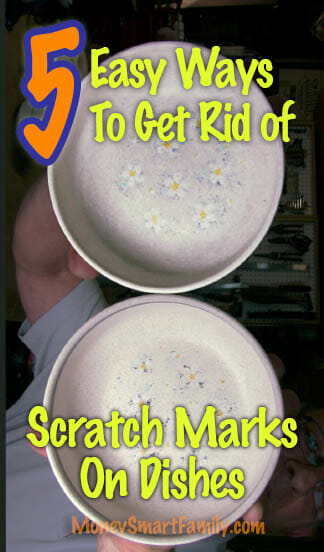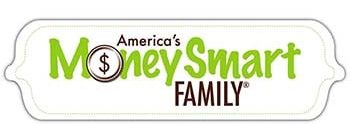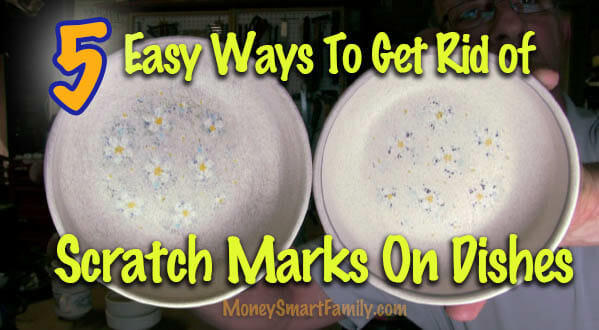Do you want to get rid of knife marks on plates? If you’re prepping for a party, the holidays or just want your stoneware or dishes to look cleaner and less worn, we’ve got 5 easy solutions for you.
Why Does Silverware Leave Utensil Marks on Plates?
Do you have these gray metal marks on your dishes? We couldn’t find a silverware or ceramics expert who shed light on why silverware, flatware or silverplate leaves metallic marks on dishes.
TABLE OF CONTENTS
Be sure to scroll to the bottom of this page to watch the video of our tests.
Different Types of Utensils
We did read some posts where people swore that real silver-plated silverware would not leave marks on plates. So we immediately went and tested with a silverplated spoon. It left a darker mark than our everyday stainless steel flatware.
So our conclusion is that no matter what type of utensils you have, silver plate or stainless steel, knife and fork marks (gray marks) may transfer to your plates.
Different Types of Plate Finishes
We also noted that metallic marks are more common on plates that have a rougher finish.
We have 4 sets of dishes:
- Correll Winter White
- Pfaltzgraff – Black Ceramic Dishes (we use these when we want to dress up the table or need extra plates for a big event like Thanksgiving)
- Temperware Dewdrops Stoneware by Lenox (this was given to us by a friend to sell)
- Freidrich Porzellan – Royal Bavarian China from Annette’s Grandmother for special dinner party events.
Of the four sets, 2 of them get metallic utensil marks on them very easily.
If you want to know how to prevent silverware marks on your plates, our theory is that the smoother or finer the finish, the fewer scuff marks you’ll see.
Our Royal Bavarian China will not show any silverware marks, no matter how hard you press. The surface is smooth like glass.
The Correll dishes do get some scuff marks, but they are very light and don’t occur easily. They have a glass-type finish.
Our two stoneware sets have more of a “tooth” on the dish surface and metal marks from utensils are very easily transferred to them.
The metal marks are fine bits of the silver plating or stainless steel being “sanded” or “filed” off of the utensil due to the coarseness of the ceramic finish on the plate.
The bottom line for keeping scuff marks from happening: the finer the finish, the fewer silverware marks you’ll experience.
RELATED ARTICLE: Peroxide & Dawn Carpet & Laundry Spot Remover
Five Ways to Get Metallic Knife Marks Off of Plates
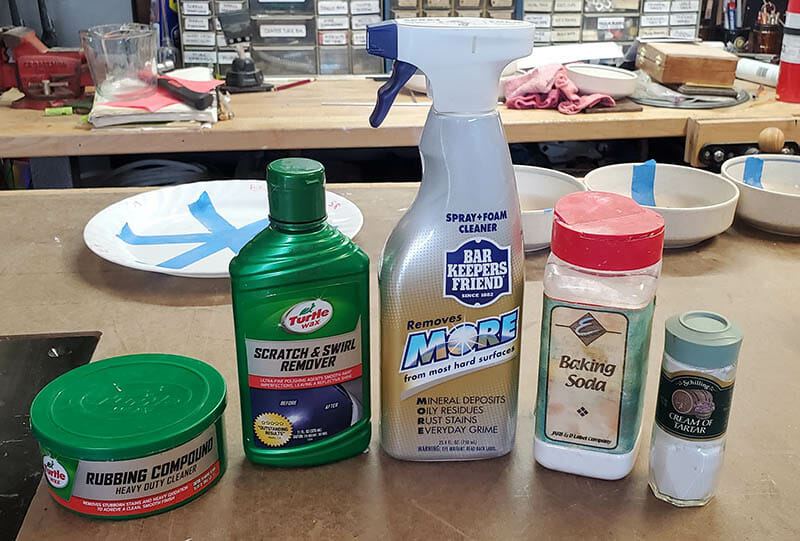
Steve set up a test in our garage workshop and pulled out five different abrasive solutions to test their effectiveness.
- Cream of Tartar (we read that this would work)
- Baking Soda
- Bar Keepers Friend
- Turtle Wax Scratch and Swirl Remover (basically a polishing compound for cars)
- Turtle Was Rubbing Compound (the most abrasive solution we tested)
The stoneware set he was cleaning consisted of plates and bowls, cups and saucers. He previously had cleaned about 15 full-sized dinner plates testing the solutions before he did his controlled test on the bowls from the Temperware dish set we were cleaning.
Steve took three bowls that had significant black scuff marks on them and put a piece of painter’s tape down the middle. He labeled each one with the initials of the solution he would test.
- Cream of Tarter (COT)
- Baking Soda (BS)
- Bar Keepers Friend (BKF)
- Scratch & Swirl Remover (SR)
- Rubbing Compound (RC)
- Control – this half of the bowl was left untouched
Steve used a clean rag with each solution to avoid contamination and to give more exacting results.
He rubbed each solution into the scuffed plate 40 times.
The plates we cleaned were Temperware Dewdrops Stoneware by Lenox. They had a flowery pattern with speckles on them. This does make them look a little dingier. Plus, they are very old.
But if you watch the video (at the bottom of the page) or look closely at the before and after photos, you’ll be able to see the abundance of scratch marks and the absence of them when the plates were cleaned.
Cream of Tartar
Cost 💲💲💲💲💲
Performance ★★★
According to Simply Recipes “Cream of Tartar is a white powder sold in the baking aisle that’s commonly used to stabilize whipped egg whites in meringues and cakes, prevent sugar crystallization in candies and caramel, and act as the activating ingredient in baking powder.”
It is a mild abrasive so we mixed it with a few drops of water to test the effectiveness of it’s cleaning ability.
Cost:
Cream of Tartar costs about $2.50 for 3.25 ounces at Target (2022 pricing)
That equates to $39 per pound – this was the most expensive solution we tested.
Performance:
After 40 rubs there was still some evidence of silver or gray knife marks on the bowl.
This is the most expensive product when compared per pound or per ounce, and the least effective.
Still, if all you have is cream of tartar and your want to get knife marks off of your plates, use it. Annette has received several bottles of Cream of Tartar for free when folks are downsizing and cleaning out their homes and spices.
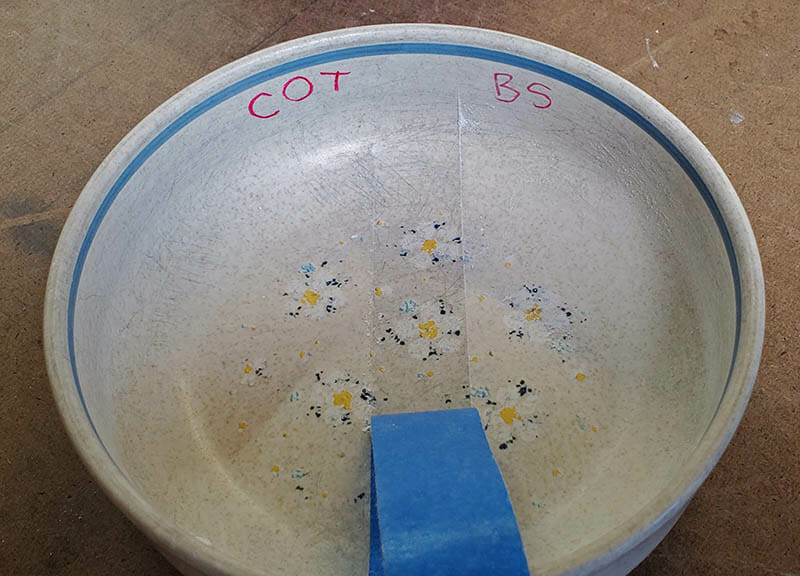
Baking Soda
Cost 💲
Performance ★★★★
Baking Soda is used in a number of ways in our household. We use it in our swimming pool to lower the Ph, in baking as an ingredient, in sour milk to eliminate the odor so it can be used in baking, as a toothpaste substitute, and as a mouthwash to reduce the acidity of Steve’s mouth when he gets a canker sore.
It also is a mild abrasive and is recommended for cleaning scratch marks off of plates. So we tried baking soda and water to clean our plates.
Cost:
Baking Soda is very inexpensive. In our area, we can buy a one-pound box for between $.75 and $1.00.
Performance:
Steve used about a teaspoon of baking soda with a few drops of water and found that after 40 rubs with a rag, the scratch marks were almost totally gone.
Baking soda is a good option, although it does require a little more “elbow grease” than the final option we tested.
Bar Keepers Friend
Cost 💲💲
Performance ★★★★★
Bar Keepers Friend has been around for a long time. Originally sold only in powdered form, it’s now available in a sprayable solution.
Cost: a 24-ounce bottle of sprayable Bar Keepers Friend costs between $3.25 and $4 in our area. The original powdered version costs between $2 and $2.50 for a 21-ounce can (about $1.90 per pound)
About Bar Keepers Friend:
According to Wikipedia, “Bar Keepers Friend was originally manufactured in 1882 as a cleaning agent in powdered form. This formulation is still manufactured today. It was invented by chemist George William Hoffman in Indianapolis, Indiana.”
The main ingredient in Bar Keepers Friend is Oxalic Acid. Oxalic Acid is an organic acid found in common fruits, vegetables, nuts, and seeds. It is a crystallized solid and is very acidic. Oxalic acid is what makes Bar Keepers Friend very good at removing hard water stains and other mineral deposits.
You might think Bar Keepers Friend is just a type of kitchen scouring cleanser, but it’s not. The top three brands of kitchen cleansers all contain Calcium Carbonate as their main abrasive ingredient. Calcium Carbonate is made from Limestone.
- Comet is one of the most popular Kitchen Cleansers and its main ingredient is calcium carbonate
- Bon Ami also uses Calcium Carbonate
- Ajax also lists Calcium Carbonate as its main active ingredient.
Performance:
Steve used about 3 sprays of Bar Keepers Friend (liquid version) on his rag and rubbed 40 times.
It was very effective at removing all of the silver fork and knife marks on the ceramic bowl.
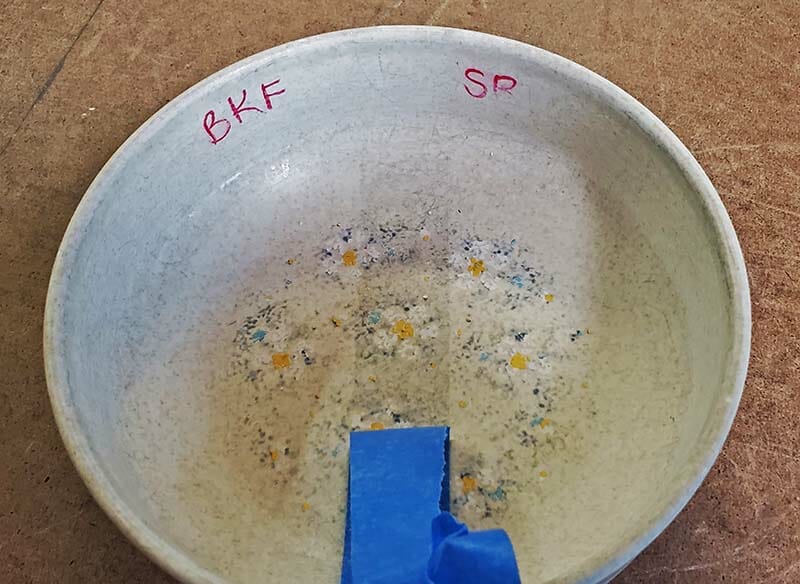
Turtle Wax Scratch and Swirl Remover – Polishing Compound
Turtle wax makes many different solutions with mild abrasives in them. The Scratch and Swirl remover we tested was purchase in 2020 and appears to be discontinued. But Turtle Wax has other products that do the same thing. Search for Turtle Wax Polishing Compound and you’ll find several options.
Cost 💲💲💲
Performance ★★★★★
Turtle Wax Scratch and Swirl remover is basically a very fine type of rubbing compound. It is designed to remove minor scratches and swirl marks from automotive paint finishes. It is considered a very mild abrasive.
Cost:
We purchased an 11-ounce bottle for less than $8 from Walmart.com. The buttons below will help you search for Turtle Wax Polishing Compounds.
Performance:
Steve used a little less than a tablespoon of the Scratch and Swirl Remover on his red rag. It worked very nicely and after 40 rubs with the rag all fork and knife marks were gone.
Turtle Wax Rubbing Compound
Cost 💲💲
Performance ★★★★★
Turtle Wax Rubbing Compound is designed to transform worn, damaged surfaces to like-new condition by smoothing scratches, swirls and ugly paint transfer marks on your car exterior. It is the most abrasive of all of the solutions we tested.
Cost:
We purchased a10.5 ounce round container for less than $6 from Walmart.com
Performance:
Steve used a damp rag and put less than a teaspoon of rubbing compound on it.. It worked amazingly fast. He stopped after 12 rubs and almost all of the scratch marks were gone from the plate. After a full 40 marks the marks were invisible.
Using Rubbing Compound on your plates to get rid of scuff marks takes the least amount of effort and is one of the least expensive options.
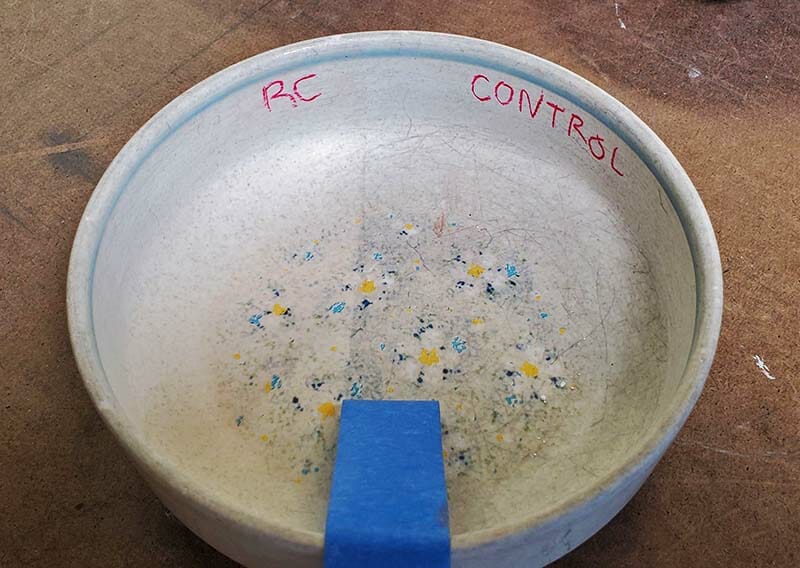
Wash Your Plates When Done
Remember to wash all items with dish soap and water after cleaning off scratch marks with these mild abrasives. These solutions all leave some residue and are not suited for consumption … with the exception of baking soda and cream of tartar.
How Often Should You Clean Knife Marks Off of Your Plates?
This is a great activity to involve your kids in or do while you’re watching your favorite TV show or sporting event.
If you have plates that have a coarser finish and get knife or scrape marks on them often, then we recommend doing this cleaning about once each year. If you have smoother finished plates then you may only need to do this once every 3 to 5 years.
Video Tests
Watch the video where Steve tests 5 different solutions to get knife and fork marks off of stoneware bowls.
Conclusion
Before and After Photo

No matter what type of dinnerware you have, it’s very easy to get knife or scratch marks off of your plates. It’s especially easy if you use Bar Keepers Friend, Turtle Wax Scratch, and Swirl Remover, or Turtle Wax Rubbing Compound. And the cost to keep your dishes looking amazing is less than $1 per year if you buy any of these solutions we tested.
